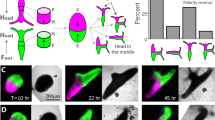Abstract
Planarian head extract was fractionated and the fractions were assayed for their effect on cultured cells and planarian regeneration. One fraction (molecular weight larger than 10 000; unadsorbable by DEAE-Sephadex, CM-Sephadex and Con A-Sepharose; and precipitable by ammonium sulfate) inhibited the growth of both Neuro 2a and PC-12 cell lines as well as planarian head- regeneration. This effect was specific for head-regeneration (regeneration of tails was not influenced), trypsin sensitive, reversible and stable after heat-treatment at 80° C for 30 min.
Similar content being viewed by others
References
Kurabuchi, S. & Y. Kishida, 1988. The role of nervous system in planarian regeneration. In S. Inoue et al. (eds), Proc. 6th M. Singer Symposium: 99–110.
Lender, T., 1955. Sur l'inhibition de la régénération du cerveau de la planaire Polycelis nigra. C. R. Acad. Sci., Paris 241: 1863–1865.
Lender, T., 1956. Analyse des phénomèmes d'induction et d'inhibition dans la régénération des planaires. Ann. Biol. 32: 457–471.
Lender, T., 1960. L'inhibition spécifique de la différenciation du cerveau des planaires d'eau douce en régénération. J. Embryol. exp. Morph. 8: 291–301.
Lowry, O. H., N. J. Rosebrough, A. L. Farr & R. J. Randall, 1951. Protein measurement with folin phenol reagent. J. Biol. Chem. 193: 265–275.
Mosmann, T., 1983. Rapid colorimetric assay for cellular growth and survival. J. Immunol. Meth. 65: 55–63.
Palmberg, I. & M. Reuter, 1983. Asexual reproduction in Microstomum lineare (Turbellaria). I. An autoradiographic and ultrastructural study. Int. J. invert. Reprod. 6: 197–206.
Palmberg, I., 1986. Cell migration and differentiation during wound healing and regeneration in Microstomum lineare (Turbellaria). Hydrobiologia 132 (Dev. Hydrobiol. 32): 181–188.
Palmberg, I., 1991. Differentiation during asexual reproduction and regeneration in a microturbellarian. Hydrobiologia 227 (Dev. Hydrobiol. 69): 1–10.
Reuter, M., 1988. Development and organization of nervous systems visualized by immunocytochemistry in three flatworm species. Progr. Zool. 36: 181–184.
Reuter, M. & K. Eriksson, 1991. Catecholamines demonstrated by glyoxylic-acid-induced fluorescence and HPLC in some microturbellarians. Hydrobiologia 227 (Dev. Hydrobiol. 69): 209–219.
Steele, V. E. & C. S. Lange, 1977. Characterization of an organ-specific differentiator substance in the planarian Dugesia etrusca. J. Embryol. exp. Morph. 37: 159–172.
Yoshizawa, Y., K. Wakabayashi & T. Shinozawa, 1991. Inhibition of planarian regeneration by melatonin. Hydrobiologia 227 (Dev. Hydrobiol. 69): 31–40.
Author information
Authors and Affiliations
Rights and permissions
About this article
Cite this article
Shinozawa, T., Shiozaki, S., Ezaki, M. et al. Regulation factor for planarian regeneration. Hydrobiologia 305, 247–253 (1995). https://doi.org/10.1007/BF00036397
Issue Date:
DOI: https://doi.org/10.1007/BF00036397




